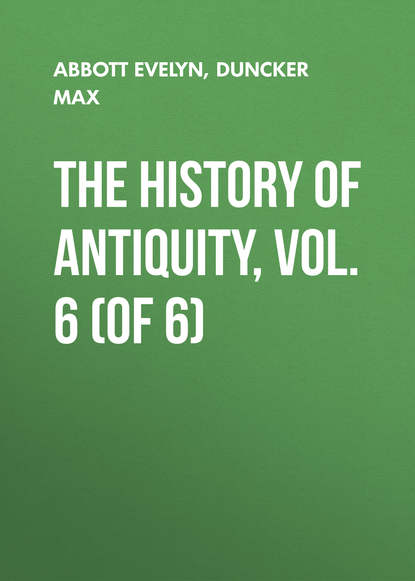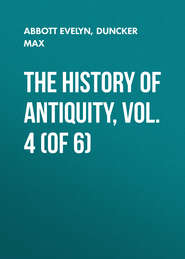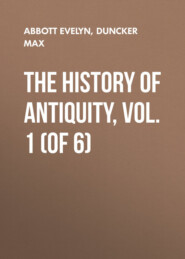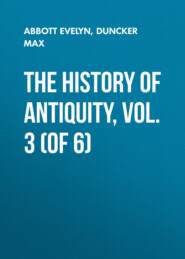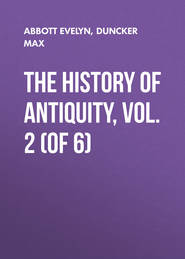По всем вопросам обращайтесь на: info@litportal.ru
(©) 2003-2024.
✖
The History of Antiquity, Vol. 6 (of 6)
Настройки чтения
Размер шрифта
Высота строк
Поля
Arrian, "Anab." 3, 16; Curtius, 5, 2, 11; 6, 9, 6, 10; Diod. 17, 66, 71; Strabo, p. 731.
129
Diod. "Exc. vat." p. 33, 2, 44; Justin, 1, 8; 2, 3; 37, 3.
130
Arrian, "Anab." 5, 4. A similar story is in Frontin. "Strateg." 2, 5, 5.
131
Polyaen. "Strateg." 8, 28.
132
Çparheghapaeça, from çpareg, to shoot, spring, and paeça, piça, shape: Müllenhoff, "Monatsberichte Berl. Akad." 1866, s. 567.
133
Strabo, p. 514, 520; Plin. "H. N." 6, 16; Ptolem. 4, 20; Curtius, 3, 2; Diod. 2, 2; Steph. Byz. Δερβίκκαι.
134
Ctes. "Pers." 6-9.
135
"Cyri inst." 8, 7.
136
Ctes. "Pers." 7; Arrian, "Anab." 6, 28; Strabo, p. 730; Plin. "H. N." 6, 29; Plut. "Alex." 69. Curtius (10, 1) asserts after Cleitarchus, that when Alexander visited the tomb of Cyrus on his return from India, he only found the shield of Cyrus, then rotten, two Scythian bows, and a sword in the sepulchre.
137
In the wings, the clothing, and the peculiar head-dress this portrait (Tenier, "Descript." pl. 84) differs essentially from the representation of Darius and his successors at Persepolis and Naksh-i-Rustem. It is not Cyrus but his Fravashi which is here represented. The building at Murghab is somewhat like the description of the tomb of Cyrus given in the text, but the site will not allow us to regard it as the tomb at Pasargadae. It must be a building which one of his successors has dedicated to the memory of the great king. The profile in the relief confirms to some degree Plutarch's statement that Cyrus had an aquiline nose, and the Persians therefore considered beaked noses the most becoming: "Praec. ger. reip." c. 30. The nose of Darius, as we see it in the monuments, appears straighter and longer.
138
The Babylonian tablets give dates from the first to the ninth year inclusive of "Kuras, king of Babylon," which entirely agree with the dates of the canon of Ptolemy, i. e. with the capture of Babylon by Cyrus 538 B.C., and the death of Cyrus in 529 B.C. On another tablet, No. 877, Br. Mus., we find the "year eleven of Cambyses king of Babylon" (E. Schrader, "Z. Aegypt. Sprach." 1878, s. 40 ff.). It is a fact established by the canon of Ptolemy as well as by Herodotus that Cambyses did not sit on the throne for eight whole years. Tablet 906 explains this eleventh year; it runs as follows: "Babylon month Kislev, day 25, year 1 of Cambyses king of Babylon, at that time Cyrus king of the lands." Hence in Babylon dates were sometimes fixed by the years of Cyrus king of Babylon, and sometimes by the years of the viceroy. If the "year eleven" of Cambyses in Babylon was the year of Cambyses' death, Cyrus must have handed over the government of Babylonia to him in the year 532 B.C., i. e. three years before his own death. This view, which has been developed by E. Schrader, I feel able to adopt against the opinion of T. G. Pinches, who wrongly assumes an abdication of Cyrus. That years were not dated from Cambyses after his death is proved by seventeen other tablets, which do not go beyond the eighth year of his reign, and two others of the 20 Elul and 1 Tisri from the first year of Barziya, i. e. of the Pseudo-Smerdis.
139
Herod. 2, 182; Diod. 1, 68.
140
Herod. 3, 1.
141
Herodotus writes Kadytis after the Egyptian name Kazatu. Vol. I. 132.
142
Herod. 2, 1; 3, 44.
143
Bekker reads 7000.
144
Ctesias, "Pers." 9; Athenaeus, p. 560.
145
Strabo, p. 758.
146
In Herod. (3, 19) the voluntary submission of the Cyprians stands in direct connection with their participation in the campaign against Egypt; hence it cannot be placed earlier. If Xenophon ("Inst. Cyri," 1, 1) represents the Cyprians as already subjugated by Cyrus, he maintains the same of Egypt also. On the other hand, the statement of Xenophon that the Cyprians retained their native kings owing to their voluntary submission is amply confirmed by later events ("Inst. 2 Cyri." 7, 4, 2; 8, 6, 8).
147
Herod. 3, 44.
148
According to Lepsius, Amasis died in January 525, and hence Memphis fell in July of this year: "Monatsberichte Berl. Akademie," 1854. The Psammenitus of Herodotus is called Psammecherites in Manetho; and Psamtik on the monuments. Rosell. "Monum. storici." 2, 153; 4, 105.
149
Diod. "Exc. de virtute," p. 557; Polyaen. "Strateg." 7, 9. In regard to the campaign we may compare the march of Pharnabazus and Iphicrates against Nectanebos in the year 374 B.C., in Diod. 15, 41-43. Aristot. "Rhet." 2, 8, 12.
150
Herod. 2, 181. De Rougé, "Revue Archeol," 8, 3; Brugsch, "Hist. of Egypt," 2, 294.
151
Aristot. "Rhet." 2, 8, 12.
152
Herod. 2, 181.
153





